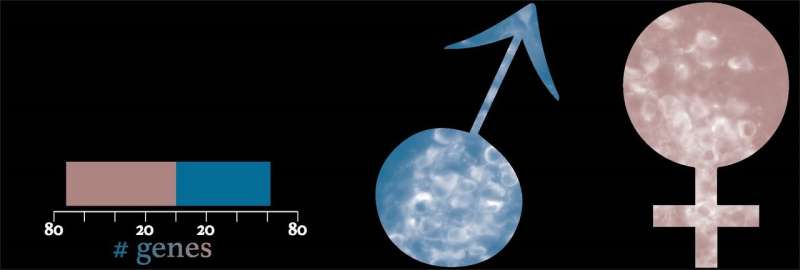Mice brain structure linked with sex-based differences in anxiety behavior

Using male individuals has long been a tradition in scientific mice studies. But new research enforces the importance of using a balanced population of male and female mice.
In a paper published May 22 in the journal Cell Reports, scientists studying the locus coeruleus brain structure in mice unexpectedly found substantial differences in the molecular structures of this part of the brain between male and female mice. They found that female mice had a three-fold higher abundance of the prostaglandin receptor EP3 (PTGER3), as well as elevated levels of Slc6a15 and Lin28b, both genes in regions associated with major depressive disorder (MDD).
"This is particularly interesting because many of the same diseases that are targeted by drugs that work on this structure, such as ADHD or depression, also really have differences in prevalence between men and women in the general population," says senior author Joseph Dougherty of the Department of Genetics at Washington University School of Medicine in St. Louis.
Women are usually two to four times more likely to suffer from depression or anxiety, and ADHD is more commonly found in males. "We thought it really striking that there was this structure in the brain that is the target of these drugs that also has this very profound molecular-level difference between males and females," he says.
The researchers initially set out to study gene expression in the mouse locus coeruleus, a small nucleus of neurons in the brain that is the primary source for the neurotransmitter norepinephrine. Norepinephrine is a major target of many drugs to treat disorders like ADHD and depression.
"We are the first to take a genome-wide view of all of the genes utilized in this small structure," adds Dougherty. In this study, he and his team studied mouse noradrenergic neurons found in the locus coeruleus in vivo and identified over 3,000 transcripts it expressed.
Because Dougherty follows current practices mandated by the National Institutes of Health since 2016, his experiments included a balanced population of both male and female mice in the experiment. When they studied the gene expression of the mice, they unexpectedly found these differences in the transcriptome between the male and female mice in this part of the brain structure.
This finding prodded the researchers to test whether this molecular difference had any functional consequences. They next delivered sulprostone, a drug targeting PTGER3, to see if they could influence its activity. When both male and female mice received sulprostone directly to the locus coeruleus via cannula after a simulated stress event, only the females responded. "We could turn off a stress-induced anxiety like behavior, specifically in the female mice, but not in the males," says Dougherty, who believes that this sex-based difference may help inform how to conduct experimentation around mood disorders and development of therapeutics.
Going forward, Dougherty plans on researching whether these molecular and functional differences in the locus coeruleus of mice are duplicated in the human brain.
More information: Bernard Mulvey et al, Molecular and Functional Sex Differences of Noradrenergic Neurons in the Mouse Locus Coeruleus, Cell Reports (2018). DOI: 10.1016/j.celrep.2018.04.054














